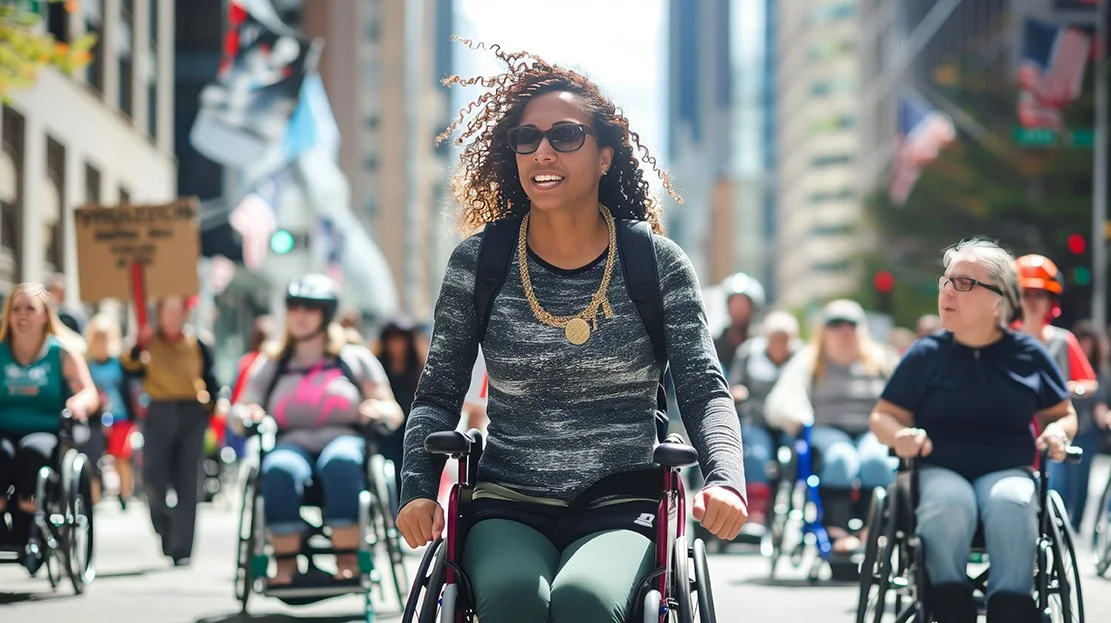Disability Doesn’t Discriminate – Why Advocacy and Accessibility Matter for Everyone
(Image: A group of CPWD consumers stands by the community garden. )
At CPWD, we work continuously to advocate for the rights, equity, and accommodations for people with disabilities. A foundational aspect of advocacy is educating people about the lived experiences of people with disabilities. People generally stand for something when they have an emotional investment in it. Currently, approximately 1 in 4 people in the United States has a disability, totaling more than 70 million people. This means about ¾ of the population may not understand or even think about how disabilities may impact their own lived experiences.
But here is the unique thing about disabilities—they can happen to anyone. As is often said in the disability community, if you live long enough, it is a community you will most likely join. Disabilities do not discriminate. It doesn’t matter if you are a man, a woman, what race, creed, or gender. It doesn’t matter what political party you belong to. It doesn’t matter if you are rich or poor. Disabilities do not discriminate. The more accessible and equitable our world is, the more it benefits and includes everyone, regardless of ability.
The Unseen Majority of Disabilities
Image: A man who has an invisible disability sits at his desk with his hands to his head, a distressed look on his face, while coworkers cheerfully conversate in the background.
While some disabilities are visible, many are invisible. Chronic illnesses such as heart disease, diabetes, and cancer are currently the greatest causes of disabilities. Mental health conditions, such as depression, anxiety, and PTSD, represent a growing segment of people with disabilities. These invisible disabilities often go unrecognized, leaving individuals to navigate workplaces, healthcare systems, and social situations without sufficient support, accommodations, or accessibility. A professional with Crohn’s disease may need frequent bathroom breaks but not be provided with an accommodation since their disability isn’t visible. A brilliant student with ADHD might struggle in traditional classroom settings without proper educational accommodations and fail to perform in “normal” academic settings. A veteran with PTSD could find crowded spaces unbearable, but lacks the workplace flexibility to take space for regulation. These daily challenges remind us that disabilities exist across a spectrum, often hidden in plain sight. Often, the narrative about our invisible disabilities falls on skeptical, if not deaf, ears simply because our disability is not visible.
An Aging Population Means More Disabilities
Statistics tell a clear story: disabilities increase with age. Today, more than 40% of Americans over 65 live with a disability. As our population ages, this percentage will only grow. Nearly 70% of seniors will eventually need some form of long-term care. These numbers aren’t abstractions about others, they represent our parents, our partners, and eventually ourselves. For those of us who do not have a disability right now, the walkers, wheelchairs, and hand-holds we see today in our grandparents’ homes will likely one day be part of our daily lives. The accommodations we advocate for today increase equity now and are investments in our collective future independence.
Accessibility is the Cornerstone of Inclusion
A woman advocates for disability rights, leading a determined group of individuals using wheelchairs during a city protest march.
Accessibility is essential for people with disabilities to live inclusive and independent lives. And, accessibility benefits more than just people with disabilities. When we design for disabilities, we create a better world for everyone. Curb cuts help parents with strollers as much as people with mobility disabilities. Closed captions assist non-native speakers alongside people who are deaf or hard of hearing. Flexible work policies benefit caregivers and people with chronic illnesses alike. Accessibility isn’t about special treatment, it’s about creating equal opportunity. Every ramp built, every policy adjusted, and every assumption challenged makes our society more inclusive for the 70 million Americans with disabilities today, for others who benefit, and for the millions more who will need accommodations tomorrow.
Many of us are people with disabilities. CPWD is a consumer-controlled Center for Independent Living. More than 70% of our board and staff are people with disabilities. And most of us, even if we don’t have a disability, know someone-a coworker, friend, or family member who does. Disabilities are part of our lives, and they are a normal part of being human. We need to remember that disabilities don’t discriminate, they affect everyone; that most of us will live with a disability if we live long enough; and that accessibility is the key to inclusive societies and accommodations that benefit many, with and without disabilities.
Disability rights are human rights, and as they are informed by people with disabilities, the policies and principles in our society will shift towards inclusion and accessibility. Discriminatory attitudes and unconscious biases will give way to recognition and acceptance. When we see the true, prevalent presence of disabilities across populations, and respond with acceptance, inclusion, and accessibility, we create a better today and work towards a future of independent living we can all look forward to.




